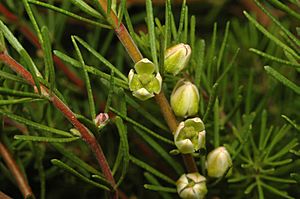Bremer boronia facts for kids
Quick facts for kids Bremer boronia |
|
|---|---|
 |
|
| Boronia clavata in Kings Park Botanic Gardens | |
| Conservation status | |
| Scientific classification |
The Boronia clavata, also known as Bremer boronia, is a special plant. It belongs to the citrus family, called Rutaceae. This plant is endemic, meaning it grows naturally only in the south-west part of Western Australia. It is a type of shrub with unique leaves and pale, yellowish-green flowers that have four petals.
Contents
What Does Bremer Boronia Look Like?
The Bremer boronia is a shrub that usually grows to be about 1–2 m (3.3–6.6 ft) tall. Its stems are covered with short, soft hairs, making them feel a bit fuzzy.
Leaves and Flowers
The leaves of this plant are quite interesting. They are mostly pinnate, which means they have smaller leaflets arranged along a central stem, like a feather. Each leaf has between three and seven small, narrow leaflets. These leaflets are about 10–20 mm (0.39–0.79 in) long.
The flowers are a soft yellowish-green color. They grow one by one where the leaves meet the stem. Each flower sits on a tiny stalk, called a pedicel, which is about 3 mm (0.12 in) long.
Petals and Stamens
Each flower has four sepals, which are like small, leaf-like parts that protect the flower bud. These sepals are egg-shaped or narrow and about 2–3 mm (0.08–0.1 in) long. They are also covered with soft hairs.
The four petals are egg-shaped and about 8 mm (0.3 in) long. Inside the flower, there are eight stamens, which are the parts that produce pollen. These stamens are shaped like small clubs and are different lengths. Some are shorter, and some are longer.
When it Flowers and Fruits
Bremer boronia usually blooms between August and October. After flowering, the plant produces small fruits. These fruits are smooth, without any hairs, and are about 4 mm (0.16 in) long and 1 mm (0.039 in) wide.
How Bremer Boronia Got Its Name
The scientific name for this plant, Boronia clavata, was first officially described in 1971. A scientist named Paul Wilson gave it this name. He wrote about it in a scientific journal called Nuytsia.
Meaning of the Name
The plant was named after a sample collected near the Bremer River. The second part of its scientific name, clavata, comes from the Latin word clava. This word means "club," which probably refers to the club-shaped stamens of the flower.
Where Bremer Boronia Lives
The Bremer boronia grows in specific places. You can find it on floodplains and along river banks. It often grows in thick groups with other shrubs. This plant is only found near Bremer Bay in Western Australia.
Protecting Bremer Boronia
The Bremer boronia is a very important plant, but it is also in danger. It is officially listed as "endangered" under a law called the Environment Protection and Biodiversity Conservation Act 1999. This means there are not many of these plants left in the wild, and they need special protection to survive.
The Department of Environment and Conservation (Western Australia) also lists it as "Threatened Flora (Declared Rare Flora — Extant)". This shows how serious its situation is and why efforts are being made to protect this unique Australian plant.


